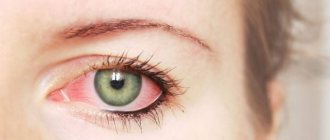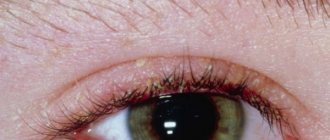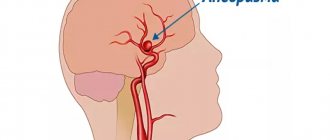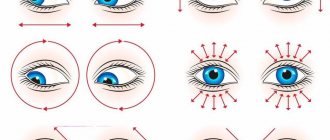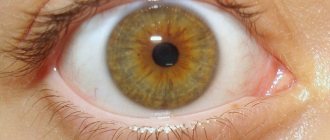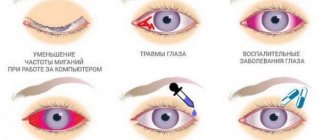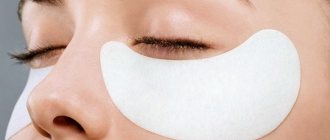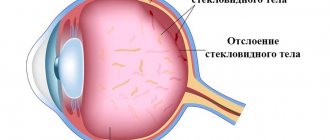Causes of eye suppuration
Pus in the eyes of a newborn can appear either immediately after the end of labor or several weeks or days after birth. Its occurrence can be provoked by internal (the presence of an inflammatory or infectious process in the child’s body) and external factors.
Among the most common reasons:
| Type of reasons that provoked suppuration | Description of specific circumstances |
| External |
|
| Domestic |
|
To protect the baby from eye suppuration, the mother should strictly follow the recommendations of pediatricians related to caring for her child. This concerns not only what kind of product to treat his eyes daily, but also how many times a day this needs to be done.
Reasons for the development of pathology
Ophthalmologists identify the following main reasons for the appearance of pus in a child’s eye:
- Conjunctivitis. This is the most common pathology in which inflammation of the mucous membrane of the eye develops. The disease may be allergic, bacterial or viral in nature;
- Dacryocystitis. Pathology develops in newborns if the protective film in the nasolacrimal duct does not break through. As a result, stagnation develops and a bacterial infection occurs;
- Glaucoma. In a child older than 4 months, purulent exudate often appears against the background of increased eye pressure;
- Uveitis. The disease causes inflammation of the choroid of the eye;
- Trachoma. It is a chronic infection that, in the absence of effective treatment, causes blindness;
- Blepharitis. It is an inflammation in the area of the ciliary edge of the eyelids. The pathology is bacterial in nature; in the absence of therapy, the disease can become chronic;
- Barley. The disease is an inflammation near the ciliary sac. If the pathology is accompanied by the appearance of purulent discharge, the doctor may suspect a staphylococcal infection.
Conjunctivitis: types and symptoms
According to medical research, the eyes fester, usually in the presence of conjunctivitis in the child’s body.
A story about how to determine the type of conjunctivitis by the appearance of your eyes:
In a newborn it is manifested by the presence of:
- swelling of the eyelids and area around the eyes;
- reddening of the proteins on one or both visual organs;
- pain, burning or itching (under such circumstances, children usually rub their eyes often and forcefully, become restless and capricious);
- intolerance to bright light;
- purulent discharge, which forms both after prolonged sleep and while the child is awake;
- sleep disturbance, severe passivity, lack of appetite;
- decreased clarity of visual perception of objects (for example, a baby stops responding to light, toys);
- increased tearfulness of one or both visual organs.
To correctly diagnose and prescribe a competent treatment regimen for conjunctivitis, pediatricians and ophthalmologists need to determine its type.
Depending on the cause that provoked the appearance of the disease in question, it may be:
- Bacterial or microbial. Occurs when microbes and bacteria enter the child’s body, in particular streptococci, staphylococci, and hemophilus influenzae. Infection occurs when hygiene rules are not followed. This type of conjunctivitis is accompanied by sharp pain and the discharge of sticky pus that forms a crust on the eyelashes after drying.
- Viral. It is a consequence of a child becoming infected with a cold, usually transmitted by airborne droplets. It appears together with signs of ARVI, in particular runny nose, coughing and sneezing.
- Chlamydia. Infection of a child occurs during childbirth if the woman in labor is a carrier of the infection or has progressive chlamydia.
The eyes of a newborn fester, most often due to bacterial conjunctivitis or dacryocystitis.
Manifestations of this type of conjunctivitis include:
- swelling of the eyelids;
- discharge of yellow, sticky pus from one or both eyes;
- redness of the whites of the eyes.
- Allergic. Occurs immediately after contact with an allergen. Distinctive symptoms are swelling and redness of the tip of the child's nose, runny nose, lack of discharge of pus, and continuous tearing.
- Gonoblenorrhea. It occurs as a result of infection of the baby’s mucous membranes with harmful microorganisms as it passes through the birth canal during natural birth.
With proper treatment, the symptoms of any type of conjunctivitis can be eliminated in 5 to 7 days.
Features of therapy
When a child’s eyes fester, treatment should take a comprehensive approach. Experts recommend using medicines and traditional medicine recipes. This will allow you to quickly eliminate unpleasant symptoms and the cause of the disease.
Drug treatment
The treatment regimen for a child will directly depend on the individual and age characteristics of the child’s body and etiological factors. When bacterial conjunctivitis develops in a newborn, the following is usually prescribed:
- washing the eyes with Furacilin solution (1 tablet dissolved in 200 ml of water), chamomile decoction or saline solution. The procedure is carried out using a cotton swab up to 8 times a day;
- instillation of 0.25% solution of Levomycetin. The drug is instilled 4-8 times a day, 1-2 drops immediately after washing. The duration of therapy is usually 3-5 days. If symptoms do not go away, then consultation with an ophthalmologist is necessary.
Bacterial conjunctivitis in children over 1 year of age is treated using the following eye drops:
- Levomycetin;
- Colbiocin;
- Tobrex;
- Eubital;
- Vitabact.
Antibacterial ointments are also widely used: Tetracycline, Erythromycin, Tobrex, Floxal.
For the treatment of adenoviral conjunctivitis, children are prescribed drops of Poludan, Inetrferon, Florenelov or 25% Tebrofen ointment. The duration of therapy is 2-3 weeks. For herpetic eye infections, Acyclovir is used in the form of ointments and tablets.
If a child’s eye festers in the spring, then an allergic reaction can be suspected. To normalize the condition in such a case, antihistamine drops are used:
- Allergodil;
- Allergophthal;
- Lecrolin;
- Spersallerg.
Additionally, for severe allergy symptoms, glucocorticosteroids (Hydrocortisone ointment, Dexamethasone drops) are prescribed.
When blepharitis develops, ophthalmologists recommend lubricating the affected area of the eye with aseptic herbal solutions and carefully removing the crusts. Additionally, you can use antimicrobial ointments (Furacilin, Tetracycline). If the cause of the pathology is a parasite (mite), then Zinc-ichthyol and Metronidazole ointments are prescribed.
Uveitis usually develops against the background of a viral, fungal, bacterial infection or parasitic infestation. Therefore, therapy for the disease involves the use of means to eliminate the cause of the disease. Depending on the type of pathogen used:
- Phenylephrine;
- Acyclovir;
- Atropine;
- Clindamycin;
- Ganciclovir;
- Lincomycin.
In advanced cases, treatment of uveitis is possible only surgically, using laser therapy, hemosorption or plasmapheresis.
Use of folk remedies
To eliminate unpleasant symptoms, it is recommended to wash with decoctions of medicinal plants that have bactericidal, healing and anti-inflammatory effects. The following recipes are widely used:
- Chamomile flowers. Take 20 g of crushed raw materials, pour a glass of boiling water, leave for 10-15 minutes. The resulting decoction is carefully filtered and applied to the affected eye using a cotton pad. The procedure should be repeated up to 3 times a day;
- Grass succession. To prepare a decoction, pour 100 ml of boiling water into 10 g of crushed raw materials. The composition is infused over low heat for 2-3 minutes, cooled, and filtered. The decoction is used to wash the eyes up to 4 times a day;
- Celandine. To prepare the product, you can use the flowers and leaves of the plant. The raw materials are crushed, 5 g of the mixture is poured into 200 ml of boiling water. The composition is simmered in a water bath for 5 minutes, cooled. It is recommended to do rinsing no more than 3 times a day.
Traditional medicine recipes should be used only after consultation with your doctor.
How to treat dacryocystitis?
For congenital pathology, conservative therapy is used for the first 2-6 months. It involves the appointment of Levomycetin and Zinc-adrenaline drops to ease the patency of the nasolacrimal duct and eliminate the infectious process.
As part of the therapy, massage of the lacrimal sac is performed 4-8 times a day. It eliminates stagnation and helps remove film. The massage is carried out with the index finger at the inner corner of the eye. To do this, do 5-10 rhythmic pressures or movements in a clockwise direction.
If after 6 months there is no positive dynamics, then bougienage is indicated. The procedure involves inserting a special probe into the nasolacrimal duct, which artificially restores the patency of the passages.
Prevention of eye diseases
The first prevention of infectious eye diseases is carried out in the maternity hospital. It involves the introduction of a solution of Sulfacyl sodium or Albucid into the conjunctival sac. This helps prevent the development of infection if the baby becomes infected during childbirth.
In the future, experts recommend adhering to the following rules:
- toilet your eyes every day;
- harden the child;
- teach children to maintain hygiene, not to touch their eyes with dirty hands;
- Follow the recommendations of nutritionists for a balanced diet for your child.
Purulent exudate in the eye area in a child develops against the background of various etiological factors. However, in most cases the pathology is infectious in nature. Therefore, ophthalmologists recommend following the rules of personal hygiene and not touching your eyes with dirty hands.
Dacryocystitis: symptoms
Purulent discharge from the eyes of a newborn can be caused by the presence of dacryocystitis. By this term, qualified specialists mean obstruction of the lacrimal canal. In the vast majority of cases, it disappears on its own after some time.
The only thing that is necessary on the part of the parents of a child with the disease in question is a massage to open the canal. The danger of dacryocystitis is that it can cause the development of conjunctivitis and similar diseases.
It can be recognized by the presence of:
- stagnation of tears in the visual organs (visually it looks like the baby is constantly crying);
- uncontrolled drainage of tear fluid from the eyes (observed when it accumulates excessively);
- “gluing” of eyelashes, both after a long sleep and while the baby is awake;
- swelling and pain in the area around the eyes;
- changes in the color of the skin of the eyelid area;
- pus released when the tear duct is pressed.
Considering the relationship between dacryocystitis and conjunctivitis, it is necessary to recognize the symptoms of the first disease in time, since its complications can trigger the occurrence of the second.
When is a doctor required?
The eyes of a newborn fester most often for reasons that only a qualified ophthalmologist or pediatrician can correct. To avoid unforeseen consequences for the child's health, parents should immediately consult a doctor in the event of this.
This should be done if:
- The child lost his appetite, as a result of which his weight gain sharply decreased.
- The child began to sleep a lot and stopped showing interest in the world around him.
- The baby’s eyes fester not only during sleep, but also during wakefulness.
- Tear fluid is not released from the eyes even when the baby is crying, but its accumulation inside the visual organ is visually noticeable.
- The newborn behaves restlessly, his daily routine is disrupted, he sleeps poorly, and is capricious for no reason.
At the initial visit, the doctor will examine the child and prescribe additional examination.
It includes:
- general blood test (to identify the inflammatory process in the child’s body);
- general urinalysis or urine analysis according to Nechiporenko;
- bacterial culture;
- smear microscopy.
Treatment is usually prescribed only if the results of all tests are available.
What to do and how to help the baby? Treatment
Of course, treatment for eye diseases should be prescribed by a doctor. This is done after determining the cause of the disease, because for each case different drugs are prescribed.
However, what can you do before a doctor’s examination to help your baby without worsening his condition? To do this, wash the eyes.
It is important to use a separate new gauze pad or pad for each eye. The following solutions can be used:
- Saline solution (buy at a pharmacy);
- Miramistin diluted with boiled water 1:1;
- Infusion of chamomile, prepared from a tablespoon of raw materials per 100 ml of boiling water. Leave for up to half an hour;
- Weak brewing of black or green tea.
The use of drops or ointments before examination by a doctor is unacceptable.
If a child is diagnosed with conjunctivitis, its nature will be immediately established. For conjunctivitis of allergic etiology, treatment is aimed at reducing allergic manifestations. The main thing is to identify and eliminate the source of the allergy. For the bacterial form of this disease, use antibacterial drops and ointments and wash the eyes with antiseptic solutions. For viral conjunctivitis, treatment depends on the pathogen. The herpetic form is difficult to treat. For acute respiratory viral infections, rinsing is enough.
When diagnosing dacryocystitis, treatment is aimed not only at relieving the inflammatory process, but also at eliminating the obstacle that caused the blockage of the canal. Most often, parents are taught to do a special massage in the area of the nasolacrimal duct. This massage helps to dissolve the remnants of the intrauterine membrane and free the canal.
If this method does not bring results, then a procedure is performed to clean the canal using a special probe, which is performed by a doctor.
A festering eye can bother your baby
Read more about ways to help your baby in the material on how to treat conjunctivitis in a child at home.
From the following material you will learn how to treat allergic cough in children using folk remedies and an inhaler.
General features of baby eye care, hygiene procedures
By properly caring for the baby's eyes from birth, parents will be able to prevent diseases that contribute to the release of pus from the visual organs.
The standard set of mandatory hygiene procedures recommended by pediatricians includes:
- In the morning and evening, wipe the baby's eyes with cotton pads soaked in chamomile infusion or boiled water (when washing, do not treat the eyes with the same cotton pad, as this can lead to the spread of infection to both visual organs if it is present on one of them) .
- You need to wipe the eye from its outer part to the nose.
- At the final stage of hygiene procedures, it is necessary to remove excess moisture from both corners of the eyes with dry cotton wool.
You need to rub your baby's eyes by pressing lightly on them. Thus, natural secretions are, as it were, “squeezed out” from the mucous membrane.
Pediatric doctors do not recommend the use of medications for preventive purposes. Not only can they worsen the current state of visual health, but they can also cause an allergic reaction in the child, cause excessive dry eyes, and also affect the quality of vision.
Eye drops for newborns
The eyes of a newborn fester due to his weak immunity, which only begins to develop when a little person is born. In the treatment of infants, medications with a minimum number of potential side effects and contraindications are usually used.
For suppuration of the eyes in children, in the vast majority of cases, the following drops are prescribed:
| Medicine | Brief characteristics and method of its use |
| Fucithalmic |
|
| Albucid or Sulfacyl sodium |
|
| Vitabact |
|
Eye drops are easy to drop into your baby's eyes without causing him any discomfort. This facilitates strict adherence to the recommended dosage, which ensures that the child’s body quickly rids itself of suppuration in the visual organs.
Blennorea
Blennorea is a complicated inflammation of the conjunctiva, most often caused by gonococcal infection.
A newborn is usually infected from the mother during childbirth. When a child is infected through the birth canal, the disease manifests itself 2-3 days after birth. First, the baby's eyelids become very swollen and red, and after a couple of days, profuse purulent discharge begins. Even the cornea of the eye may be affected. This serious disease can lead to complete loss of vision. Therefore, it requires urgent qualified treatment.
In addition to gonococci, blenorrhea can also be caused by other infections (chlamydia, streptococci). However, gonoblennorrhea is the most difficult to treat and has serious consequences.
Currently, thanks to preventive measures after the birth of a child (the use of antibacterial drops or ointments immediately after birth) and mandatory tests carried out during pregnancy, blenorrhea is extremely rare.
Why a baby's eye is festering - only a doctor can determine
Eye ointments for newborns
The more viscous consistencies of the drugs used to restore the health of children's eyes contribute to the uniform distribution of the active substance throughout the mucous membrane. Despite this benefit, eye ointments are not popular among parents of newborns.
They are inconvenient to use in the treatment of a small child - the baby squeezes his eyes after applying the product, which pushes most of it onto the eyelid.
Among the drugs that have proven effective in relieving children of eye suppuration, the most often prescribed by ophthalmologists are:
- Erythromycin ointment . An affordable product (average price - 100 rubles), the active component of which is erythromycin. According to the instructions, the ointment must be applied to the baby under the lower eyelid 2-3 times a day. The maximum duration of treatment is 14 days.
- Floxal ointment. The active ingredient ofloxacin allows the drug to successfully relieve the symptoms of bacterial and viral infections of the visual organs. The recommended dosage is to place a small amount of the product (no more than 1.5 cm) behind the affected eyelid 2-5 times a day. within 7-10 days.
Eye wash solutions
With proper treatment, the eyes of a newborn fester for no more than 7 days. The easiest way for parents and the most enjoyable way for children to treat the visual organs during this period is to wash them with a specialized solution.
Eye treatment with Furacilin
Furacilin is a universal antiseptic drug for the treatment of eye diseases caused by bacteria, viruses, infections and a number of protozoa. It can be prescribed in the form of tablets, an aqueous or alcoholic solution. To rid a newborn of suppuration of the eyes, only an aqueous solution is used.
To prepare it you need:
- Sterilize a small dish in which the resulting medicine will be stored. Wash your hands thoroughly.
- 1 tab. Furacilin must be crushed as much as possible until it becomes powdery. Pour the resulting mass into ½ cup of hot water, the temperature of which should be at least 37 degrees. Otherwise, the tablet will not dissolve and the concentration of the active substance will not be maintained.
- The ingredients should be thoroughly mixed and left to infuse for 1-2 hours.
- Once the solution reaches room temperature, it must be filtered through gauze or a fine strainer.
- After getting rid of small particles that pose a potential danger to the eyes of a recently born baby, dip a sterile bandage or gauze folded in three into the solution.
- Rub both eyes in the direction from the outer corner of the eye to the inner.
For effective treatment, it is recommended to treat the eyes of a newborn 3-4 times a day. In this case, a new portion of the solution should be prepared at least once every 2 days.
Saline eye wash
To relieve a newborn baby from suppuration of the eyes, saline solution is also used. If the processing recommendations are followed, sodium chloride will be effective both in the complex treatment of eye diseases and as a prevention of infectious, microbial and viral diseases.
- Wash your hands and take a sterile bandage, first folding it into 4 layers.
- Depending on the packaging of the solution, moisten the prepared bandage generously by squeezing sodium chloride through the neck of the bottle or using a sterile syringe.
- Rub the eye, moving your hand from the outer corner of the eye to the inner.
- Use dry sterile cotton wool to remove excess solution from the baby’s face.
Sodium chloride is absolutely harmless to the child's body and can even be used as a hygienic means of washing the child on a daily basis.
How to treat pus in a child's eyes
It is not recommended to treat a 1-12 month old child on your own. The specialist must take into account the individual characteristics of the baby before prescribing effective therapy, especially if the cause of suppuration is viral or bacterial infections. If purulent processes develop in the spring, then most likely it is allergic conjunctivitis, so antihistamines are needed. Infectious pathologies are treated with antibacterial ointments, and if the eyes of a month-old baby are festering due to dacryocystitis, then only a special massage will help.
First aid
It is not always possible to see a doctor, so if the eyeball is red, runny, swelling of the mucous membrane and purulent discharge from the child’s eye, it is necessary to provide him with first aid:
- If after sleep the baby cannot open the eyelid, the crusts need to be softened. To do this, a cotton swab should be soaked in a warm 0.2% solution of furatsilin, a weak solution of potassium permanganate, weak tea or herbal decoction. Irrigation stimulates the opening of the optic ducts.
- After washing the eye, you need to drip it with a 10% solution of albucid. To do this, the lower eyelid should be pulled back and the pipette should be directed to the outer corner.
- Warm herbal infusions and tea for rinsing can be used every 2 hours. Use drops for instillation 4-6 times a day.
- It is contraindicated to further treat the baby on your own. Treatment with antibiotics without a doctor's prescription is prohibited.
- How to make a husband jealous and afraid of losing his wife - advice from a psychologist and men
- Loperamide - instructions for use for children and adults. Loperamide prices
- Cervicitis - what kind of cervical disease is it? Symptoms and treatment of chronic and acute cervicitis in women
How to wash a child's eyes
Treating a child is a responsible and serious matter. If pus begins to accumulate in the baby’s eyes, dried chamomile or calendula flowers are suitable for washing them. Infusions are easy to prepare. To do this, put 1.5 tbsp in a 200 ml bowl. l. chamomile, calendula or a mixture of plants purchased at the pharmacy. Then fill it with boiling water to the brim, cover with a lid and let it brew for two hours. The temperature of chamomile decoction for instillation into a child’s eyes should not exceed 37 degrees.
Drug treatment
Suppuration of the eyes requires immediate treatment. Initially, the doctor prescribes drug therapy, which is based on the causes of the pathology. If the medications do not give a positive result, and the child’s eyes constantly fester, then surgical intervention is required. For conjunctivitis, the doctor may prescribe the following medications:
- Acyclovir (tablets). The drug helps with viral infections caused by herpes. The recommended dose for children over 2 years of age is 200 mg 5 times a day for 5 days. In case of overdose, adverse reactions are possible in the form of nausea, vomiting, headaches, and confusion.
- Levomycetin (alcohol solution). A topical antimicrobial that is used for bacterial eye infections. Children over 1 year of age are prescribed 2-3 drops 1-2 times a day. The doctor prescribes the duration of the course individually. Sometimes allergic reactions develop in children in the form of eye burning and itching.
Drops for pus in the eyes
Drops are prescribed to children for inflammation, when the eyes are watery and sticky due to pus flowing from them. The drugs are produced in the form of a solution placed in a special dropper bottle. Depending on the pathogen, eye drops may belong to the antibacterial or antiviral group. Most drugs have anti-inflammatory, antiallergic, analgesic and immunomodulatory properties. Popular drugs for children:
- Torbex. Broad-spectrum antibiotic of the aminoglycoside group. Prescribed for the treatment of conjunctivitis for children over 1 year of age. Rarely used for infants. Recommended dosage is 1 drop 5 times a day. Duration of treatment – 1 week. If the dose is exceeded, there is a danger of deterioration in kidney function and the development of muscle paralysis.
- Phloxal. Antibacterial drops that provide a lasting and rapid therapeutic effect. Children's dosage – 1 drop every 6 hours for 14 days. Treatment should not be interrupted after symptoms disappear.
Eye ointments
There are many ointments for the treatment of eye diseases. They are used depending on the causative agent of the disease. It is easy to find non-steroidal antimicrobial, steroidal hormonal, antihistamine and combined topical medications on sale. The following drugs are most often prescribed for the treatment of childhood eye diseases:
- Florenal ointment. Suppresses the proliferation of viruses that cause damage to mucous membranes. Apply the ointment behind the eyelid 2 times a day, morning and evening. The duration of treatment depends on the degree of infection by the virus. In advanced stages of adenovirus, the ointment is used for 1-2 months. The drug should not be used by children with hypersensitivity to its components.
- Tetracycline ointment. A broad-spectrum antibiotic prescribed for children over 8 years of age. The recommended dosage for eye infections is to apply the ointment under the lower eyelid 3 to 5 times a day. Duration of use – from 3 to 30 days. The ointment is contraindicated for use in cases of abnormal blood composition, liver and/or kidney dysfunction.
Special massage
For dacryocystitis, ointments, drops and eye washes will not bring a therapeutic result. To improve the condition, you must first remove the film using a special massage, the technique of which should be shown to the parents by a doctor. Before performing the procedure, you should wash your hands thoroughly and ensure that your nails are trimmed. Using your finger up and down, you should massage the inside of your baby's eye very gently. 6-10 movements are done in one session. If there is a lot of pus coming out of the lacrimal sac, it means that the procedure is being performed correctly.
Phytotherapy
A newborn’s eyes fester not only due to diseases present in his body, but also due to non-compliance with hygiene rules. Herbal decoctions (for example, calendula) and infusions (for example, chamomile) are actively used by parents to wash the visual organs of their babies.
According to recent studies, natural remedies have been found effective when used not only as preventive measures, but also in the treatment of eye diseases in children.
The most popular herbal medicines are:
- Black tea compress.
- 2 tsp. black large-leaf tea, pour ½ liter of boiling water, then close the lid and let it brew.
- After the tea has acquired a dark brown hue, strain it through cheesecloth or a fine strainer.
- After waiting for the product to cool to room temperature, pour it into a clean container.
- Dip small pieces of sterile cotton wool into the tea, then squeeze them out and apply them to the child’s eyelids for 15 minutes.
- This must be done while the baby is sleeping, trying as much as possible not to disturb the baby. The relaxed state of the eyelids guarantees uniform distribution of tea throughout the mucous membrane for the purpose of its further disinfection.
- Camomile tea.
- 3 tbsp. l. dry chamomile flowers pour 1 liter of boiling water.
- Stir thoroughly, cover with a lid and let brew for 3-4 hours.
- After making sure that the infusion has cooled down and has a brown tint, use a sterile bandage or cotton wool to wipe the newborn’s eyes from the outer corner of the eye to the inner one.
- The frequency of the procedure is 3-4 times per day.
- Calendula decoction.
- 3 tbsp. l. Mix dried calendula flowers or leaves with 800 ml of cold water.
- Place on the fire and bring to a boil, stirring constantly.
- After this, the resulting mixture should be simmered over medium heat for 10 minutes.
- Remove from heat and let sit in a dark, dry place.
- After 3 hours, strain the broth and treat the newborn’s eyes with it.
- To do this, you need to moisten sterile cotton wool in it and wipe the visual organs from the temple to the nose.
Before starting to use phytotherapeutic methods in the treatment of a newborn, it is important to make sure that he does not have allergies or individual intolerance to the natural ingredients of a particular product.
How to do rinsing?
Washing is done only with clean hands. Each time take a new cotton swab. Use a decoction of chamomile, a solution of furatsilin or an infusion of strong black tea. Furacilin is considered a completely safe medicine for newborns. Dissolve 1 tablet in half a glass of hot boiled water. Rinsing can begin when the solution has cooled to body temperature. For each wash it is necessary to prepare a new solution. Dirt and foreign objects should not get into the medicine.
When rinsing with a swab, move from the outer edge of the eye to the inner one.
Pharmaceutical solution of furatsilin cannot be used. It contains alcohol. Using it on mucous membranes is strictly prohibited.
Eye wash for conjunctivitis
When eliminating suppuration of the eyes in babies caused by conjunctivitis of any type, ophthalmologists recommend that parents wash the baby’s visual organs as often as possible.
The most effective means in the fight against the disease in question are:
- Furacilin solution (3 - 4 times / day for 7 - 10 days);
- tea leaves (1 - 2 times a day for 10 days);
- potassium permanganate (1 – 2 r/day for 7 days);
- herbal infusions containing chamomile, calendula or sage (3 - 4 times a day for 10 - 12 days);
- boiled water (as often as possible).
The basic rule that parents need to follow when washing the eyes of a child with conjunctivitis is to observe the rules of personal hygiene before and after the procedure. Otherwise, you can worsen the condition of the newborn or become infected yourself.
Directions of treatment
First aid
When a newborn’s eyes fester, you should definitely consult a doctor. But parents can provide first aid. It consists of removing pus and washing the mucous membrane with solutions with antiseptic and anti-inflammatory properties. It is important to treat both eyes to prevent the infection from spreading.
Solutions options:
- From plants - chamomile, calendula or black tea. Pour 1-1.5 tablespoons of raw material with a glass of boiling water. Leave for 1 hour. Filter.
- From furatsilin. Dissolve 1 tablet in 100 ml of boiling water. Cool.
- From Miramistin. Dilute the solution with water in a 50/50 ratio.
Processing algorithm:
- Make sure the solution temperature is close to body temperature.
- Soak a cotton pad or piece of bandage in the liquid.
- Rub the eye from the outer corner to the inner.
- Take a clean disk and repeat all manipulations with the second eye.
You should wash your eyes every 2 hours. It is advisable to prepare the cleaning solution before use.
There is an opinion that in a situation where a newborn’s eye begins to fester, breast milk should be instilled into it. This cannot be done. Despite all the benefits of milk, it is a favorable environment for the growth of bacteria and can increase inflammation and discomfort.
If allergic conjunctivitis is suspected, it is necessary to exclude the child from contact with a possible irritant: remove plants, soft toys, carpets from his room, and keep animals away. Frequent wet cleaning and regular ventilation are necessary. The same measures are appropriate for any inflammation.
Relieving inflammation
To effectively treat sour eyes, it is necessary to determine the causative agent of the disease. The most accurate method is bacterial culture of secretions from the lacrimal canals. But often doctors focus on external signs.
If the inflammation is caused by a virus, then drops with an antiviral effect are prescribed: Actipol, Poludan, Trifluridine. In addition, ophthalmic ointments can be used - oxolinic, Tebrofenovaya, Bonafton. In mild cases, it is enough to wash the eyes with antiseptic solutions and instill drugs with interferon, for example, Ophthalmoferon.
For bacterial inflammation, local antibacterial drugs are necessary. The most popular eye drops for newborns are Albucid. In addition, chloramphenicol (0.25%), gentamicin (0.3%), ciloxan (0.3%), tsifran (0.3%) and other antibiotics in the form of drops are used. Ointments can be prescribed - tetracycline, chloramphenicol. Systemic antibiotics in the form of tablets or injections in infancy are used only in severe cases, for example, with blennorrhea.
General treatment plan:
- Lay the baby horizontally without a pillow. Wash his eyes with an antiseptic solution.
- Warm the bottle with drops in your hands.
- Pull back the lower eyelid and drop the required amount of medicine using a pipette with a rounded end. It's good if someone holds the child's head.
- Remove excess drug with a clean napkin.
Usually the medicine needs to be injected into the conjunctival sac 3-4 times a day. The ointment is applied 1-2 times. To do this, move back the lower eyelid and squeeze a thin strip onto its inner surface.
Features of treatment for dacryocystitis
With dacryocystitis, it is important not only to destroy the pathogenic flora, but also to eliminate the cause of the disease - blockage of the duct. The easiest way is to massage the tear duct. Parents can conduct it themselves after training. It involves stroking movements with the thumb from the outer edge of the eyebrow, along its line, near the bridge of the nose, to the wings of the nose and in the opposite direction. Manipulations should be carried out with light pressure, but so that the child does not hurt. Frequency – 6-8 times a day.
If the massage does not lead to the removal of the “plug,” then the child is placed in a hospital and the lacrimal canal is cleaned (bougienage) under local anesthesia using a catheter. The procedure is painless. You should not refuse it, since without eliminating the blockage of the duct, attacks of dacryocystitis will be repeated, and adhesions will gradually form in the canal.
Festering eyes in a small child is a condition that requires urgent attention to a doctor. Its most common causes are conjunctivitis, dacryocystitis and blenorrhea. Parents can help their baby on their own by washing the eyes with herbal or medicinal solutions with an antiseptic effect. Only a doctor can prescribe a full range of treatment. As a rule, therapy lasts 7-10 days, after which the child fully recovers. The main measures to prevent infection are washing the eyes twice a day with boiled water or chamomile solution, as well as observing the rules of hygiene for adults.
Massage for suppuration of the eye
To avoid drug treatment in case of obstruction of the baby's tear duct, parents can massage him regularly. It will not only help the body cope with dysfunction on its own, but will also protect it from potential side effects of medications.
Massage involves simple actions and does not take much time:
- Squeeze out any accumulated fluid from the tear duct.
- Using a pipette, drop 2 drops of Furacilin solution into each eye.
- Remove excess solution and pus using cotton wool or a bandage.
- Lightly pressing and pushing the liquid in the canal, perform 10–20 massage movements in the inner corner of the eye from top to bottom and vice versa.
- Place 1 drop of Levomethicine in each eye.
Massage of the lacrimal canal during suppuration of the eye should be carried out at least 5 - 7 times a day. within 14 – 30 days.
Dacryocystitis. How is it different from conjunctivitis?
Dacryocystitis is a disease associated with inflammation of the lacrimal sac due to blockage of the nasolacrimal duct.
There are cases when in a newborn the lumen of the canal connecting the inner corner of the eye with the nasal cavity is narrowed or clogged with residual elements of the embryonic membrane, which should dissolve after birth. In such a situation, the tear fluid does not flow into the nasopharynx through the canal, as it should, but collects in the lacrimal sac.
With stagnation, tears lose their protective properties, because the microbes that they wash away from the eye are not removed, but accumulate in the lacrimal sac. Its inflammation begins and, as a result, suppuration of the eye begins.
With dacryocystitis, the following symptoms occur:
- The main symptom that distinguishes this disease from others is that when pressure is applied in the area of the nasolacrimal duct, a purulent discharge appears from its opening in the eye;
- The inner corner of the eye turns red;
- Due to disruption of lacrimal outflow, excessive lacrimation may occur;
- When treated with antibacterial drops and antiseptics, the condition does not improve significantly and appears again;
- Signs of an infectious disease may occur
Fever, swelling in the eye area, weakness.
Treatment of dacryocystitis can only be performed by a specialist, as it has its own characteristics.
Advice from Dr. Komarovsky
Dr. O.E. Komarovsky, who enjoys authority among modern parents, believes that despite the typical situation when newborn babies’ eyes fester, parents should immediately contact a pediatric ophthalmologist. Usually the cause of suppuration is a blockage of the tear duct.
To get rid of this as soon as possible you need to:
- Identify the true reason that provoked the souring of the baby’s eyes.
- If the tear duct is blocked, parents need to regularly give the baby appropriate massage.
- If there is no improvement in its patency, it is worth consulting with a pediatrician about the possibility of probing.
- Avoid self-medication. According to the pediatrician, even what to wash the baby’s eyes with for preventive purposes should be decided by the ophthalmologist.
In order to prevent the occurrence of purulent discharge from the eyes of a recently born child, his parents need to thoroughly wipe the visual organs of the newborn with boiled water, and do this 2 times daily.
It is also important to monitor the behavior of the baby in order to recognize the symptoms of an eye disease in time and immediately eliminate it.
Article design: E. Chaikina

